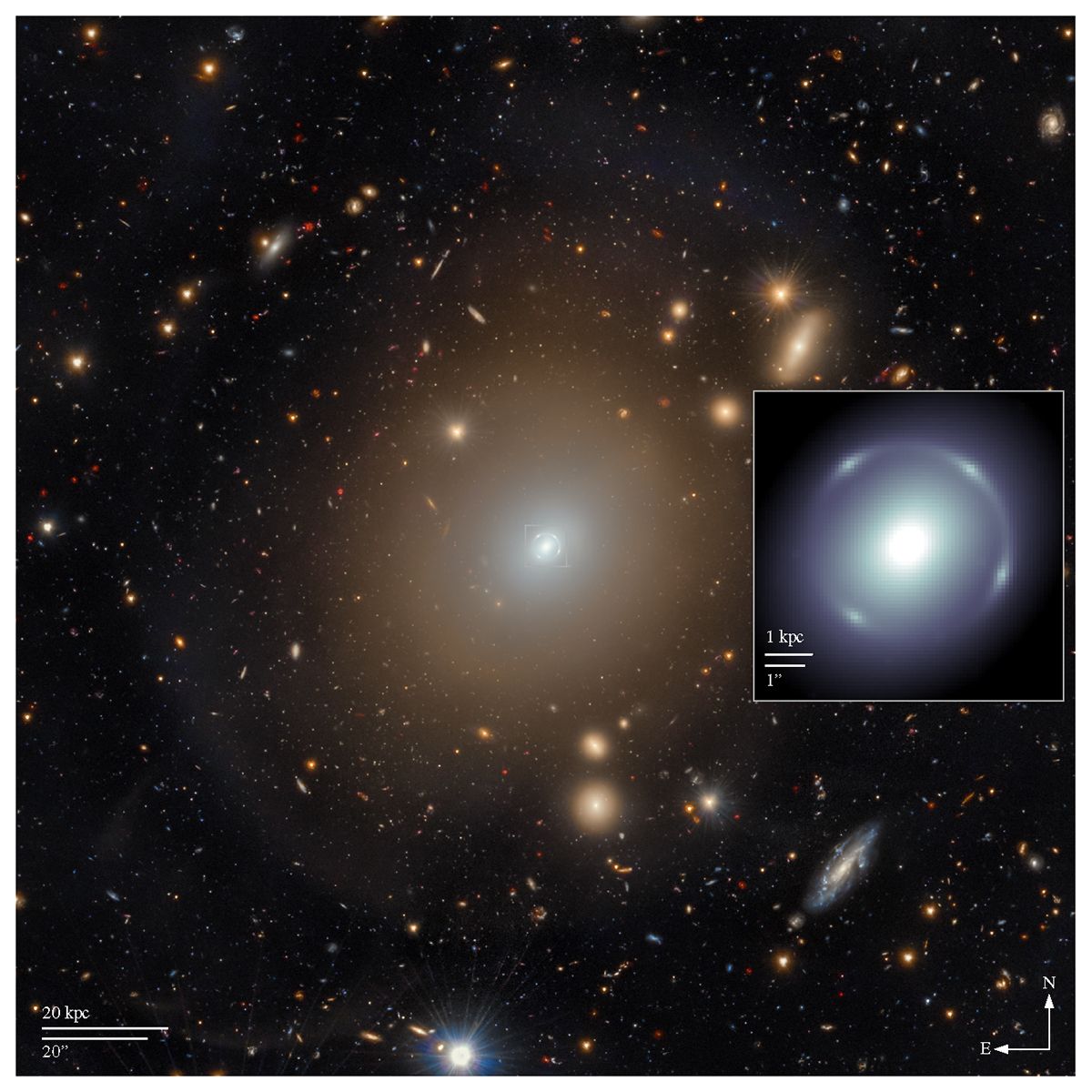Spectacular: this Einstein ring was right under our noses, but no one had seen it 🌀
Published by Cédric,
Article author: Cédric DEPOND
Source: Astronomy & Astrophysics
Other Languages: FR, DE, ES, PT
Article author: Cédric DEPOND
Source: Astronomy & Astrophysics
Other Languages: FR, DE, ES, PT
Follow us on Google News (click on ☆)

Image of the Euclid data used in this study, where the Altieri lens was discovered.
The main panel shows a false-color composite image combining VIS and NISP data. The brightness is defined by the higher-resolution VIS IE image, while the color comes from the lower-resolution NISP YE, JE, and HE images.
The central light of the galaxy is attenuated to better reveal the gravitational arc. The inset shows only the high-resolution VIS data on the central 8″ area, indicated by the square in the main panel.
Launched in July 2023 by the European Space Agency (ESA), Euclid's mission is to explore the mysteries of the dark Universe. From its initial testing phases, the telescope spotted a nearly perfect Einstein ring, a gravitational mirage formed by the bending of light from a distant galaxy. This discovery, made in a well-known galaxy, highlights Euclid's power and promises major advances in cosmology.
A phenomenon predicted by Einstein
The Einstein ring observed by Euclid is a direct illustration of the theory of general relativity. According to Albert Einstein, light bends in the presence of massive objects, creating gravitational lensing effects. When the alignment between a massive galaxy and a distant galaxy is perfect, the light from the latter forms a bright ring around the former.
In the case of NGC 6505, the galaxy located 590 million light-years away distorts the light from an even more distant galaxy, 4.42 billion light-years away. This phenomenon, although predicted long ago, had never been observed around this galaxy, which has been studied since the 19th century.
A serendipitous but revealing discovery
The Einstein ring was spotted by chance during Euclid's initial tests. The first images, intentionally blurred, revealed an intriguing circular structure. After analysis, scientists confirmed it was indeed an Einstein ring, a rare and valuable phenomenon for cosmological research.
Valeria Pettorino, a scientist on the Euclid project, emphasizes the importance of this discovery. She notes that finding such a ring in a well-known galaxy shows Euclid's ability to reveal previously invisible phenomena. This foreshadows major discoveries in the years to come.
A tool to unravel the mysteries of the Universe
Einstein rings are not just cosmic curiosities. They allow scientists to study dark matter, an invisible substance that makes up a large part of the Universe. By analyzing the distortion of light, researchers can map the distribution of this mysterious matter and better understand its role in cosmic structure.
Euclid, designed to study weak gravitational lenses, has already demonstrated its ability to detect strong lenses. This early discovery confirms the telescope's potential to explore large-scale gravitational phenomena.
A promising mission
Euclid's mission is just beginning. Over the next six years, the telescope will map more than a third of the sky, observing billions of galaxies. Scientists hope to discover up to 100,000 gravitational lenses, some of which could reveal even deeper secrets about the dark Universe.
This first discovery of an Einstein ring marks an important milestone for Euclid. It illustrates the power of this instrument and hints at major advances in our understanding of the Universe and its invisible forces.
To go further: What is a gravitational lens?
A gravitational lens is an astrophysical phenomenon where the light from a distant object is bent by the gravity of a massive object located between that object and the observer. Predicted by Einstein's theory of general relativity, this light distortion allows us to observe galaxies or stars that would otherwise be invisible.
When a massive object, such as a galaxy or a cluster of galaxies, is aligned with a distant light source, its gravity curves spacetime. This curvature acts like a lens, amplifying and distorting the light from the background object. Depending on the alignment, this can create multiple images, bright arcs, or even a perfect ring, called an Einstein ring.
Gravitational lenses are classified into two categories: strong and weak. Strong lenses, like the Einstein ring observed by Euclid, produce spectacular and easily visible distortions. Weak lenses, on the other hand, cause subtle deformations, requiring statistical analysis to be detected.
These phenomena are valuable tools for cosmologists. They allow the study of dark matter distribution, the measurement of cosmic distances, and the testing of theories about the expansion of the Universe. Gravitational lenses thus offer a unique window into the mysteries of the invisible Universe.